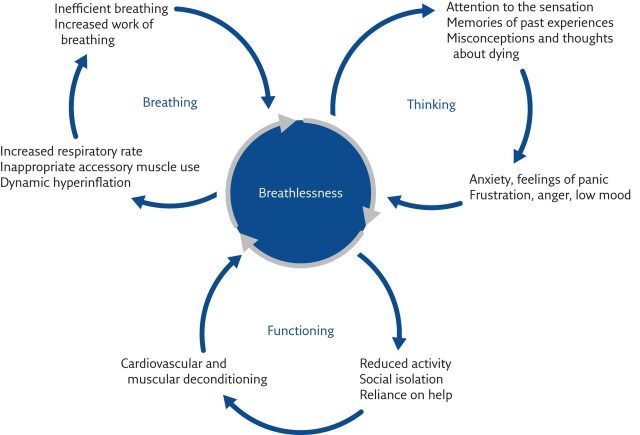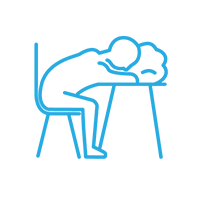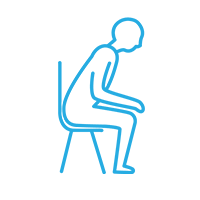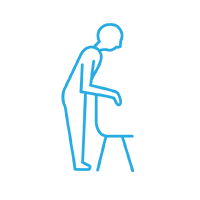
Breathlessness can be a difficult symptom to live with but there are ways you can reduce its impact on your life.
This diagram shows how breathlessness affects, our thoughts, how we breathe, and how we go about our daily activities.

In conditions such as chronic obstructive pulmonary disease (COPD) there is not enough time for your lungs to empty when breathing fast. The next breath in starts before your lungs have fully emptied, making each breath stack up on the one before. Your chest then over-expands, making breathlessness worse. Breathing becomes increasingly harder and recovery takes longer.
There are things that can help improve breathing including cooling your face with a fan (portable breath of fresh air) and repositioning yourself to a more comfortable position.
Often breathlessness can cause anxiety. Feeling frightened or anxious can increase muscle tension, which in turn increases the effort of breathing. This vicious cycle can lead to panic and faster breathing.
Things that can be helpful include learning to relax, gradually slowing your breathing, and finding a calm state of mind.
Sometimes to avoid the unpleasant and frightening feeling of breathlessness it is natural to try and reduce activity levels. However, this can lead to muscles becoming weaker. Weakened muscles use oxygen less efficiently, further making breathlessness worse.
It’s helpful to understand that breathlessness caused by being active is not harmful and can actually improve breathlessness over the longer term. Regular exercise or walking more can also help.
Tips for managing breathlessness and conserving energy
These tips may help you recover quicker from breathlessness after activity. They may also help your breathing to settle if you are feeling panic or assist you to manage your stable long-term breathlessness.
However, if you feel your breathing is getting worse or the feeling of breathlessness is new to you it is important to seek advice from your doctor.
Breathing techniques
Breathing Control/Tummy Control -Take slow, deeper breaths from your tummy.
- Rise – feel your tummy lift as you breathe in
- Relax as the breath out
- Rest and wait for the next breath to come
Pursed Lip Breathing – breathe in through your nose (smell the roses), breathe out, as if through a straw (blow out the candles).
Blow as you go – Breathe in before exerting effort, breathe out while making the effort.
Paced breathing – breathe in for a few counts, breathe out for a few counts.
Breathe around the rectangle – follow the side of a rectangle with your eyes as you tummy breathe. Gradually slow the speed at which your eyes move around the edge of the shape to slow your breathing.
Positions to ease breathlessness
There is no one position which suits everyone, nor one position which people particularly prefer
Most positions involve leaning forward as this improves the movement of the diaphragm (the main muscle used for breathing). Changing the position of your arms may also help your diaphragm and other muscles move into a better place for breathing.
Here are some examples of positions that may help ease breathlessness. It is best to try a variety of positions to find the one that works for you.
Note: With all positions try to relax your hands, wrists, shoulders, neck and jaw as much as possible.

Resting position
Relaxing down onto pillows with your legs apart may help if you are breathless at rest or if you are feeling tired or exhausted.

Following activity
Lean forward with arms resting on your knees or the sides of a chair and position knees slightly apart.

Use of walking aids
Lean forward with arms resting on a surface. If you notice that walking is easier when you are using a shopping trolley the same would apply when using a Gutter Frame, wheely frame or walking stick. All these aids enable you to maintain a forward lean position of ease while walking.
Distraction and meditation
Focus on things that bring you pleasure or calmness such as mindfulness or meditation. This could be something as simple as focusing your attention on slowly opening and closing your fists while counting to 50, to shift your focus from how you are feeling.
Cognitive Behavioural Therapy (CBT) also has a role in managing breathlessness and helping to manage feelings of distress and anxiety. CBT looks at the person’s individual situation including their physical symptoms, thoughts, emotions and behaviours to create a clear picture of what they are experiencing to them identify strategies to improve their quality of life.
For more information on CBT, click here.
Physical activity
Regular activity should be done in moderation. A step counter can help you monitor this and help you to be more aware of how much you are moving. Too much sitting with minimal movement can be harmful to your lungs.
Ask your doctor to be referred to your local rehabilitation program so you can keep moving with the right support.
For more information on pulmonary rehabilitation, click here.
Conserve energy
Look for ways to reduce your exertion and save your energy.
- Plan your day: set aside time for a break
- Prioritise tasks: decide what is most important
- Adapt tasks: find an easier way
- Delegate: ask for help
